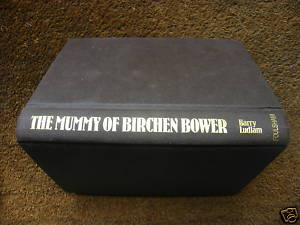The Golden Ghost of Mold #4: Ludlam’s Account August 18, 2013
Author: Beach Combing | in : Modern, Prehistoric , trackbackAnother from our series on the Golden Ghost of Mold. This report dates from 1966 and from Harry Ludlam’s fun The Mummy of Birchen Bower. Ludlam was a ‘gifted amateur’ with a better grasp of facts, in this case, than the Oxford published Walter Johnson, who we were a little rude about in a previous post (while remaning a huge fan, sorry, Walter!):
On a bright night in the early part of the last century, an old woman walked to the town of Mold, in Flintshire, to lead her husband home from a public-house. The couple were about a quarter of a mile out of town on their homeward journey, walking along the Chester road, when the woman, who was walking a little ahead of her husband, was startled to see cross the road in front of her a warrior-like figure which she later described as ‘of unusual size, and clothed in a coat of gold, which shone like the sun.’ The apparition then vanished quite suddenly into a gravel bank on the other side of the road.
When her husband came up she told him what she had seen. He laughed at her fancy, as did the many others to whom she repeated her story the next morning. There was a vague local tradition that the bank was haunted and it was commonly known by the name of Bryn-yr Ellyllon, or the Goblins’ Hill. Despite that, however, no one took the old woman’s tale of the golden ghost very seriously.
A section of the gravel bank had been cut off in making that part of the Chester road, and gravel for various purposes having been dug out of the remainder, a large pit had been made in the field adjoining the road. When, some years after the old woman’s experience, farmer John Langford bought the piece of land for his farm, he employed some labourers to fill the unsightly hole by shovelling down the top of the bank to the level of the rest of the field.
As the workmen progressed, they found themselves removing much bigger stones, including several very large round ones, and at a depth of about four feet from the top of the mound — obviously the original surface of the ground — they came upon what seemed to be an outsize breastplate or corselet, some three-and-a-half feet long and eight inches wide in the centre. It lay as it might have been worn, with the breast upwards and the back parts doubled behind. Under it were discovered the bones of a man, and a little above it, as the body had been buried, a skull.
The discovery was made on October 11th, 1833. The vicar of Mold, the Rev Charles Butler Clough, reported: ‘The corselet suffered considerable mutilation. Mr Langford, upon its discovery, having no idea of its value, threw it into a hedge, and told the workmen to bring it with them when they returned home to dinner. In the meantime several persons broke small pieces off it.’
The corselet, richly decorated with heavily embossed work, was in fact a thin solid plate of gold. Today it is a unique and priceless exhibit in the British Museum, where also are filed the reports of the farmer and the vicar, who tells the story of the apparition seen by the old woman and testifies that it was ‘an undoubted fact’ that she had related it at the time. The odd thing, adds the vicar, was that one of the people to whom she had told her story, years before, was farmer Langford himself, who, like all the rest, had taken little account of it.
There is a sequel. In recent years the corselet has been established as being not a portion of some rich warrior’s armour, but a peytrel or breastplate for the horse on which he rode. The whereabouts of the restless soldier’s own golden armour, if it still exists, remains a mystery, as does his identity. The apparition may still walk, and his armour lie, in the region of Mold, where certainly some families today include among their prized possessions gold rings and breast-pins known to have been made from pieces broken off the corselet as it lay discarded in the hedge.
This last paragraph should be taken as the flourish of a dramatic writer. The idea that the corselet belonged to a horse has been rejected and there is, in fact, now the idea, though this lies beyond absolute proof, that the tenant of the tomb was actually a woman: this on the basis of the grave goods he/she took to the otherworld with them. For other reports on the Golden Ghost of Mold: drbeachcombing AT yahoo DOT com



